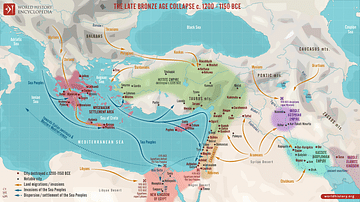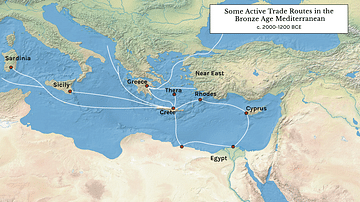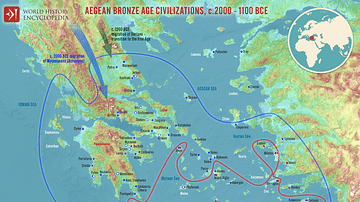The Nebra Sky Disk is one of the most fascinating, and some would say controversial, archaeological finds of recent years. Dated to 1600 BCE, this bronze disk has a diameter of 32cm (about the size of a vinyl LP) and weighs around 2 kg. It is patinated blue-green and embossed with gold leaf symbols which appear to represent a crescent moon, the sun (or perhaps a full moon), stars, a curved gold band, interpreted as a sun boat, and a further gold band on the edge of the disk which probably represent one of the horizons (another gold band on the opposite side is missing).
Bronze Age Treasure
The object was discovered in 1999 CE by treasure hunters using a metal detector at a prehistoric enclosure encircling the Mittelberg hill, near the town of Nebra in the Ziegelroda Forest, 111 miles (180 km) south-west of Berlin, Germany. Unfortunately, the treasure hunters caused considerable damage to the disk during its crude removal from the ground, which included splintering its outer rim, losing one of the stars, and chipping a large piece off the gold disk.
The looters subsequently attempted to sell the disk, along with two swords, two axes, a chisel, and fragments of armlets, to local archaeologists. They soon discovered, however, that by law the objects belonged to the state of Sachsen-Anhalt, where they were unearthed, so they could not be sold legally. In February 2003 CE, they tried selling the disk to an antiquities collector in Switzerland for $400,000. However, the 'collector' was actually working for the Swiss police as part of a 'sting' operation to trap the group, which played out in the basement bar of the Hilton hotel in Basle. The group were subsequently arrested and the disk was recovered. It is now the property of the state of Sachsen-Anhalt.
As mentioned above, the disk illustrates the crescent moon, a sun or full moon, three arcs, and 23 stars dotted around, apparently at random. There is a further cluster of seven stars, identified as the Pleiades constellation. X-rays have revealed two more stars underneath the gold of the right arc, suggesting that the two arcs were added later than the other features. The blue-green background of the night sky was once coloured a deep violet-blue, apparently by applying rotten eggs, causing a chemical reaction on the bronze surface. Running along the edge of the disk is a ring of holes punched through the metal, probably for attaching the disk to something, perhaps a piece of heavy cloth.
What is the Nebra Sky Disk?
So what exactly is the Nebra Sky Disk and what was it used for? Many researchers believe it is the oldest known realistic representation of the cosmos yet found, perhaps a kind of astronomical calculational tool to determine planting and harvest times. used as an advanced astronomical clock. For thousands of years all across northern Europe, monuments were aligned to mark the summer and winter solstices; Stonehenge in Wiltshire, England and Newgrange in Ireland are the most famous examples.
As Bronze Age people were an agricultural society, a method for finding out the time of year, and thus the correct times for planting and harvesting crops, was obviously vital. One way of doing this was to identify the position of the sun at sunrise and sunset. Intrigued by the possibility of the Nebra disk as an astronomical-astrological device, Professor Wolfhard Schlosser, of the University of Bochum, measured the angle between the pair of arcs on either side of the disk, and found that it was 82 degrees.
Fascinatingly, at Mittelberg hill, between the high mid-summer sunset and the low mid-winter sunset, the sun appears to travel around 82 degrees along the horizon. This angle would vary from place to place; further north, for example, it would be 90 degrees, and to the south, 70. But in a restricted belt of central Europe, the sun's passage across the sky measures precisely 82 degrees. Schlosser concluded that the pair of arcs along the circumference of the Nebra disk did indeed depict the sun's solstices accurately for its location. This would suggest that the Bronze Age agricultural societies of Central Europe made sophisticated celestial measurements far earlier than has been accepted.
Ancient Astronomy
Some researchers have pointed to the presence of the Pleiades star cluster on the disk as further evidence of Bronze Age astronomical knowledge. Although nowadays there are only six stars in the Pleiades visible to the naked eye, in the Bronze Age one of the group's stars may have been much brighter, thus accounting not only for the depiction of seven stars on the disk, but also for the ancient Greek name for the cluster - the 'Seven Sisters'.
The Pleiades was an important constellation for many ancient civilisations, including those of Mesopotamia and Greece. The constellation would have appeared in their skies in the autumn, showing that it was time to start bringing in the harvest, and disappeared in the spring, indicating the time for planting crops. This evidence for the importance of the disk in connection with prehistoric agriculture may mean that the (third) golden arc underneath the crescent moon and golden disk in fact represents a sickle.
Others have suggested that the disc actually represents the day-time sky and that the unexplained arc depicts a rainbow. But the majority of researchers believe this third arc to be a 'sun ship'. There are depictions of a disk in a ship from Bronze Age Scandinavia, and a Danish artefact dating to the 15th/14th century BCE, the 'Trundholm Sun Chariot', depicts a horse drawing the sun in a chariot. But the main source of the symbol, and the ancient belief that a ship carried the sun across the night sky from the Western to Eastern horizon, is ancient Egypt. Their belief was that Ra, the sun god and their most powerful deity, journeyed through the night sky on a ship and that, in the morning, at sunrise, he would be reborn. If the golden arc at the bottom of the Nebra disk does in fact represent a sun ship travelling across the night sky, then it would be the first evidence of such a belief in Central Europe.
Germany's Stonehenge - The Goseck Circle
There is further proof of prehistoric celestial knowledge in the area, a mere 15 miles (25 km) distant from where the Nebra disk was discovered. Lying in a wheat field near the town of Goseck, and first identified from aerial photographs, is the remains of what is thought to be Europe's oldest observatory. 'Germany's Stonehenge' as it has become known, consists of a huge circle, 246 feet (75 m) in diameter, and was built by the earliest farming communities in the area around 4,900 BCE. Originally the site consisted of four concentric circles, a mound, a ditch and two wooden palisades about the height of a person.
Within the palisades were three sets of gates, facing south-east, south-west and north, respectively. The two southern gates marked the sunrise and sunset of both the summer and winter solstice. At the winter solstice, watchers at the centre of the circles would have witnessed the sunrise and set through the south-east and south-west gates. It is surely safe to assume that if these southern gates marked the sunrise and sunset at the winter and summer solstice, then the inhabitants of Goseck were able to accurately determine the course of the sun in its journey across the sky. In fact, the angle between the two solstice gates in the Goseck circle corresponds with the angle between the gilded arcs on the rim of the Nebra sky disk.
Although the Nebra disk was created 2,400 years later than the Goseck site, Professor Wolfhard Schlosser believes there may be some connection between the two in the astronomical knowledge they both display. Schlosser has even suggested that the details on the disk were based on previous astrological observations, possibly made at the primitive observatory at Goseck.
Is the Nebra Disk a Hoax?
In late 2004 CE, the Nebra disk became enmeshed in controversy. German archaeologist Professor Peter Schauer, of Regensburg University, claimed that the disc was a modern fake, and any claim that it was a Bronze Age map of the heavens was 'a piece of fantasy'. Professor Schauer stated that the supposedly Bronze Age green patina on the artefact had probably been artificially created in a workshop 'using acid, urine and a blowtorch' and was not ancient at all. The holes around the edge of the disk, he insisted, were too perfect to be ancient, and must have been made by a relatively modern machine. His own conclusion was that the object was a 19th century CE Siberian Shaman's drum.
However, it later emerged that Schauer had never studied the artefact himself prior to making his claim, nor did he publish any of his theories in a peer-reviewed journal. But Schauer's objections still shocked the German archaeological community and raised some important questions about the authenticity of the disk.
The first was that, because of the circumstances of its discovery, the Nebra disk had no secure archaeological context. Thus, it was extremely difficult to date accurately, especially as there was nothing similar with which to compare it. The dating that was done on the object depended upon the typological dating of the Bronze Age weapons which had been offered for sale with it and were supposed to be from the same site. These axes and swords were dated to the middle of the 2nd millennium BCE.
Solid evidence for the antiquity of the disc was provided by the Halle Institute for Archaeological Research in Germany. The Institute submitted the artefact to an exhaustive series of tests that confirm its authenticity. For example, the copper used on the disk has been traced to a Bronze Age mine deep in the Austrian Alps. Tests also discovered that a practically unique mixture of hard crystal malachite covers the artefact. In addition to this, microphotography of the corrosion on the disc has also produced images that proved that it was a genuinely ancient artefact and could not be have been produced by a faker.
The latest examinations of the disk, by a group of German scholars in early 2006 CE, came to the conclusion that it was indeed genuine and had functioned as a complex astronomical-astrological clock for the synchronization of solar and lunar calendars. In 2010 CE, scientists at Mainz and Halle Wittenberg universities in Germany speculated that the disk may have fallen out of use after the catastrophic volcanic eruption on the Mediterranean island of Thera (modern Santorini). The scientists believe that the huge blanket of ash that obscured the sky perhaps all the way to Central Europe for two or three decades brought an end to the cult of sun-worshipping. Their faith was shaken by the effects of the eruption - reduced temperatures, crop failures - and the culture which manufactured the Nebra Sky Disk simply discarded the artefact.
The Nebra Sky Disk is the earliest known guide to the heavens yet discovered, and certainly, along with the Goseck site, the first examples of detailed astrological knowledge in Europe. But perhaps that is not the end of the story. Wolfhard Schlosser believes, intriguingly, that the disk, currently valued at $11.2 million, was one of a pair, and that the other is still out there waiting to be found, somewhere at the Nebra site.








